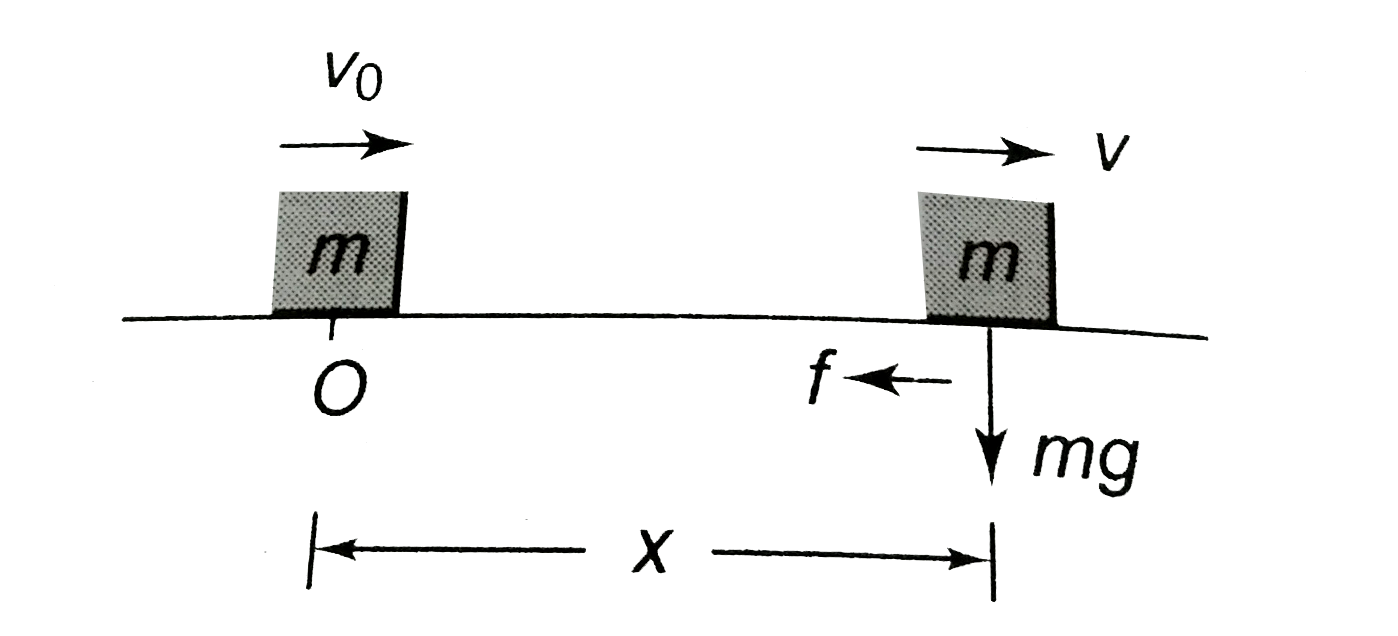A small body of mass is given velocity at point on rough horizontal surface. (a) Find the mean power developed by the friction force during the whole time of motion if the friction coefficient is constant and equal to (b) Find the maximum instantaneous power developed by the friction force, if the friction coefficient varies as , where is a constant and is the distance from the point .

(a) Loss in work done against friction
Work done by friction
Retardation of body
The time after which the body stops
(b) Retardation of body
here retardation is variable Velocity of body as a function of
Instantaneous power delevered by friction
For to be maximum,
or
Topper's Solved these Questions
Similar Questions
A small body of mass m is located on a horizontal plane at the point O. The body of mass m is located on a horizontal plane at the point O. The body acquires a horizontal velocity v0. Find,
(a) the mean power developed by the friction force during the whole time of motion, if the friction coefficient k=0.27, m=1.0kg, and v0=1.5m/s,
(b) the maximum instantaneous power developed by the friction force, if the friction coefficient varies as k=αx, where α is a constant, and x is the distance from the point O.View SolutionA small body of mass m lies on a horizontal plane. The body is given a velocity v0, along the plane. (a) Find the mean power developed by the friction during the whole time of motion, if friction coefficient is μ=0.3,m=2.0kg and v0 = 3 m/s. (b) Find the maximum instantaneous power developed by the friction force, if the friction coefficient varies as μ=αx, where α is a constant and x is distance from the starting point
View Solution
Knowledge Check
- Question 1 - Select One
An object of mass (m) is located on the horizontal plane at the origin O. The body acquires horizontal velocity V. The mean power developed by the frictional force during the whole time of motion is ( μ= frictional coefficient )
AμmgVB12μmgVCμmgVgD32μmgV - Question 2 - Select One
A particle of mass m is given a velocity u on a rough horizontal surface of friction coefficient μ. The average power imparted by friction until it stops is
AzeroB12μmguCμmguD2μmgu
A small body of mass m is located on a horizontal plane at the point O. The body of mass m is located on a horizontal plane at the point O. The body acquires a horizontal velocity v0. Find,
(a) the mean power developed by the friction force during the whole time of motion, if the friction coefficient k=0.27, m=1.0kg, and v0=1.5m/s,
(b) the maximum instantaneous power developed by the friction force, if the friction coefficient varies as k=αx, where α is a constant, and x is the distance from the point O.View SolutionA small body of mass m moving with velocity v0 on rough horizontal surface, finally stops due to friction. Find, the mean power developed by the friction force during the motion of the body, if the frictional coefficient μ=0.27,m=1 kg and v0=1.5ms−1.
View SolutionA small body of mass m is located on a horizontal plane at the point O. The body of mass m is located on a horizontal plane at the point O. The body acquires a horizontal velocity v0. Find,
(a) the mean power developed by the friction force during the whole time of motion, if the friction coefficient k=0.27, m=1.0kg, and v0=1.5m/s,
(b) the maximum instantaneous power developed by the friction force, if the friction coefficient varies as k=αx, where α is a constant, and x is the distance from the point O.View SolutionA block of mass 2kg is given velocity 10m/s on a rough horizontal surface of friction coefficentμ=0.2. Find the magnitude and the direction of friction force acting on it. After how much time and at what distance it will stop ?
View Solution
For the surface μ=0.4 find the work done by the applied force, friction and net force.View SolutionA block of mass m moving with a velocity v0 on a rough horizontal surface from x=0 coefficient of friction is given by μ=μ0=ax. Find the kinetic energy of the block as function of x before it comes to rest.
View Solution

